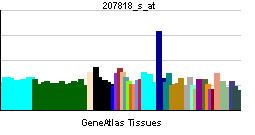Entrez 3363 | Ensembl ENSG00000148680 | |
 | ||
Aliases HTR7, 5-HT7, 5-HT7 receptor, 5-hydroxytryptamine receptor 7 External IDs MGI: 99841 HomoloGene: 20244 GeneCards: HTR7 | ||
The 5-HT7 receptor is a member of the GPCR superfamily of cell surface receptors and is activated by the neurotransmitter serotonin (5-hydroxytryptamine, 5-HT) The 5-HT7 receptor is coupled to Gs (stimulates the production of the intracellular signaling molecule cAMP) and is expressed in a variety of human tissues, particularly in the brain, the gastrointestinal tract, and in various blood vessels. This receptor has been a drug development target for the treatment of several clinical disorders. The 5-HT7 receptor is encoded by the HTR7 gene, which in humans is transcribed into 3 different splice variants.
Contents
Function
When the 5-HT7 receptor is activated by serotonin, it sets off a cascade of events starting with release of the stimulatory G protein Gs from the GPCR complex. Gs in turn activates adenylate cyclase which increases intracellular levels of the second messenger cAMP.
The 5-HT7 receptor plays a role in smooth muscle relaxation within the vasculature and in the gastrointestinal tract. The highest 5-HT7 receptor densities are in the thalamus and hypothalamus, and it is present at higher densities also in the hippocampus and cortex. The 5-HT7 receptor is involved in thermoregulation, circadian rhythm, learning and memory, and sleep. It is also speculated that this receptor may be involved in mood regulation, suggesting that it may be a useful target in the treatment of depression.
Variants
Three splice variants have been identified in humans (designated h5-HT7(a), h5-HT7(b), and h5-HT7(d)), which encode receptors that differ in their carboxy terminals. The h5-HT7(a) is the full length receptor (445 amino acids), while the h5-HT7(b) is truncated at amino acid 432 due to alternative splice donor site. The h5-HT7(d) is a distinct isoform of the receptor: the retention of an exon cassette in the region encoding the carboxyl terminal results a 479-amino acid receptor with a c-terminus markedly different from the h5-HT7(a). A 5-HT7(c) splice variant is detectable in rat tissue but is not expressed in humans. Conversely, rats do not express a splice variant homologous to the h5-HT7(d), as the rat 5-HT7 gene lacks the exon necessary to encode this isoform. Drug binding affinities are similar across the three human splice variants; however, inverse agonist efficacies appear to differ between the splice variants.
Discovery
In 1983, evidence for a 5-HT1-like receptor was first found. Ten years later, 5-HT7 receptor was cloned and characterized. It has since become clear that the receptor described in 1983 is 5-HT7.
Clinical significance
This receptor gene is a candidate locus for involvement in autistic disorder and other neuropsychiatric disorders.
Ligands
Numerous ligands bind to the 5-HT7 receptor with moderate to high affinity.
Agonists
Agonists mimic the effects of the endogenous ligand, which is serotonin at the 5-HT7 receptor (↑cAMP).
Antagonists
Neutral antagonists (also known as silent antagonists) bind the receptor and have no intrinsic activity but will block the activity of agonists or inverse agonists. Inverse agonists inhibit the constitutive activity of the receptor, producing functional effects opposite to those of agonists (at the 5-HT7 receptor: ↓cAMP). Neutral antagonists and inverse agonists are typically referred to collectively as "antagonists" and, in the case of the 5-HT7 receptor, differentiation between neutral antagonists and inverse agonists is problematic due to differing levels inverse agonist efficacy between receptor splice variants. For instance, mesulergine and metergoline are reported to be neutral antagonists at the h5-HT7(a) and h5-HT7(d) receptor isoforms but these drugs display marked inverse agonist effects at the h5-HT7(b) splice variant.
Inactivating antagonists
Inactivating antagonists are non-competitive antagonists that render the receptor persistently insensitive to agonist, which resembles receptor desensitization. Inactivation of the 5-HT7 receptor, however, does not arise from the classically described mechanisms of receptor desensitization via receptor phosphorylation, beta-arrestin recruitment, and receptor internalization. Inactivating antagonists all likely interact with the 5-HT7 receptor in an irreversible/pseudo-irreversible manner, as is the case with [3H]risperidone.
